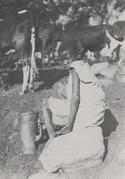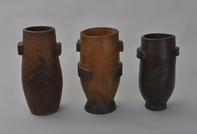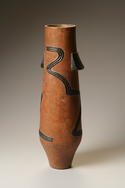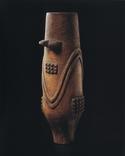
Until quite recently, carved milk pails were used by communities throughout much of rural South Africa. These vessels were almost invariably cylindrical in form. Hollowed vertically from logs, some examples have handles or solid lugs near the rim. Many also have slightly swelling bellies, but no legs of any kind. In most communities, cows were milked by the herd boys who looked after the homestead’s animals, leading them to pastures in the early morning and driving them back to the protection of cattle byres at night.

Writing in the 1970s on the taboos associated with rituals practiced by rural traditionalists, Raum indicated that both the cattle and the milk pails of the heads of homesteads became the property of their heirs after they died. Because of the link between cattle and the homestead’s ancestors, newly married women were prevented from drinking milk or eating meat from cattle belonging to their husbands. For this reason also, they were not allowed to touch or clean milk pails, leaving others in the homestead to decant fresh milk into gourds and other containers.

Milk pails were commissioned by the heads of homesteads for use by male members of the family. These vessels were made by accomplished specialist carvers who often achieved a wonderful sense of elegance through the elongation of the form. In this example, the sinuous line of the pokerwork decorative motif animates the surface in a very individual way. Variations in the style of milk pails can be ascribed to the hands of different carvers, some of whom became so famous in the nineteenth and twentieth centuries that their names were recorded.

Although milking and all other chores associated with cattle were restricted to men, it has been suggested that milk pails evoke the bodies of women both because of their slightly bulbous shape and the fact that they are used to collect fresh milk. Some examples, like this one, have breast-like lugs and additional decorations that allude to the idea of arms and scarification on a human body.

Functionally the raised decorations on milk pails affords the user some traction when holding it between the knees to milk a cow. Lugs near the rim of these vessels prevent them from slipping to the ground and the narrow aperture keeps the fresh milk from clotting too soon.